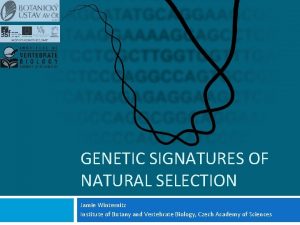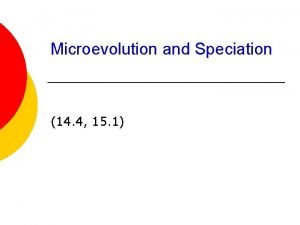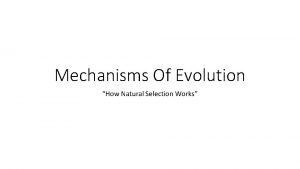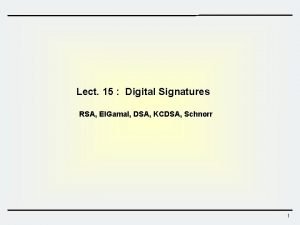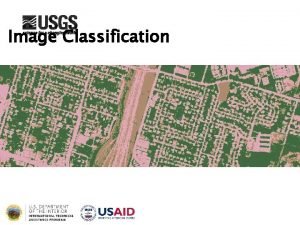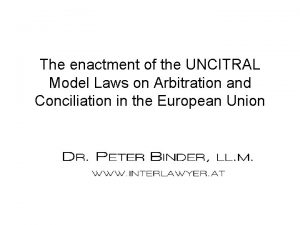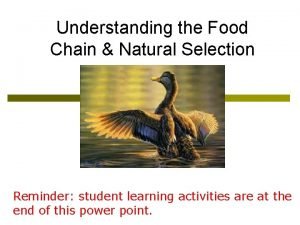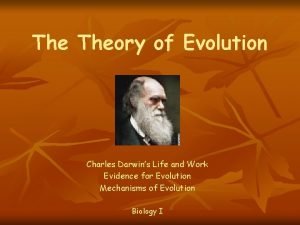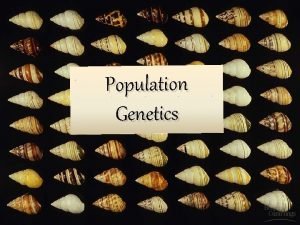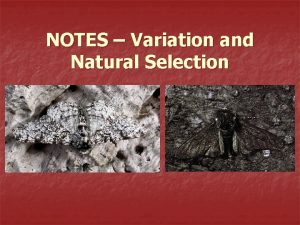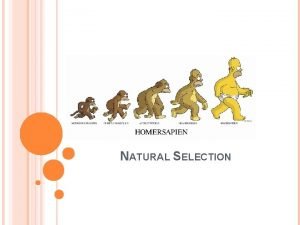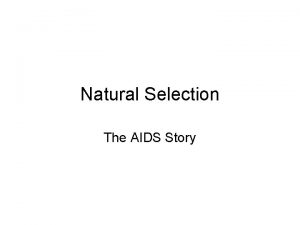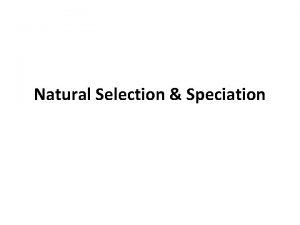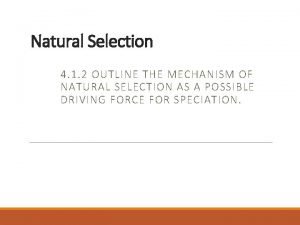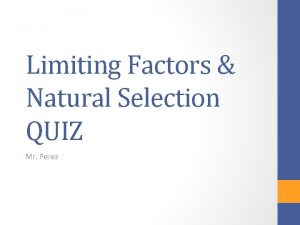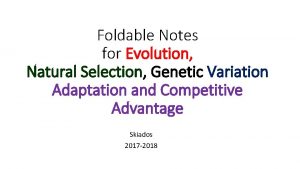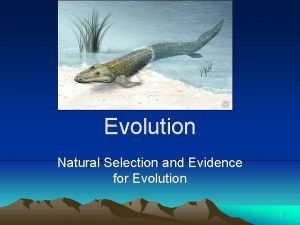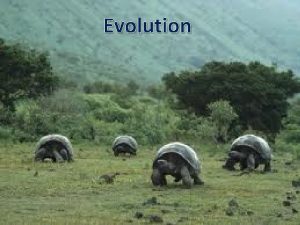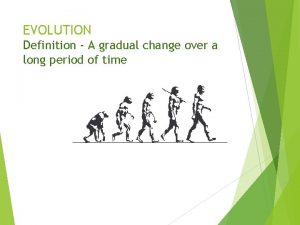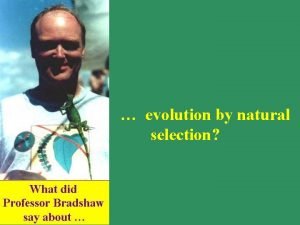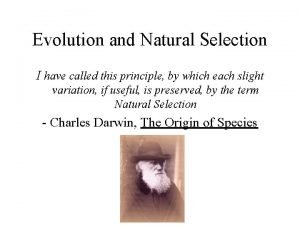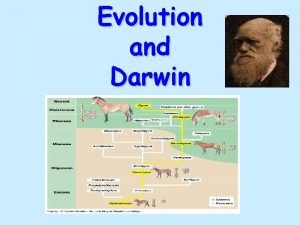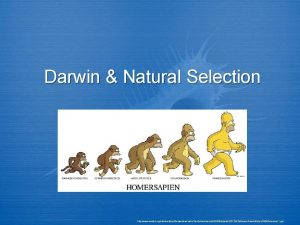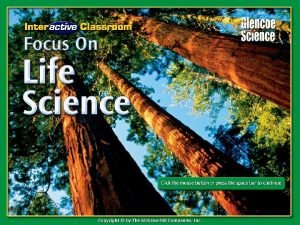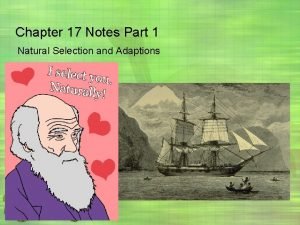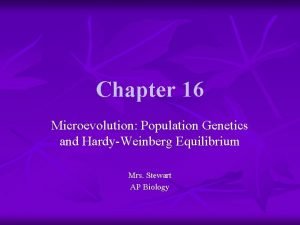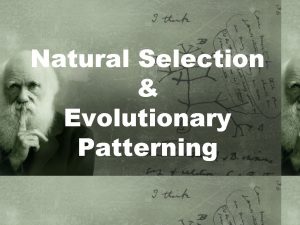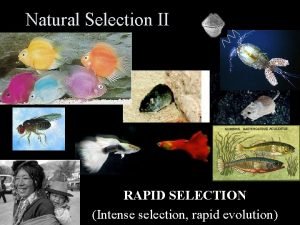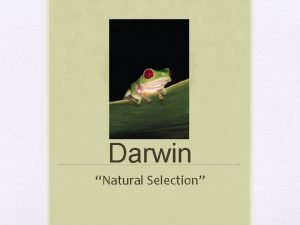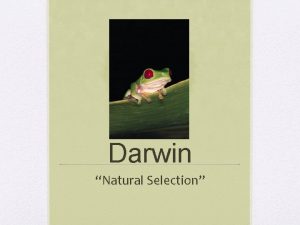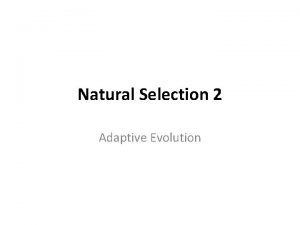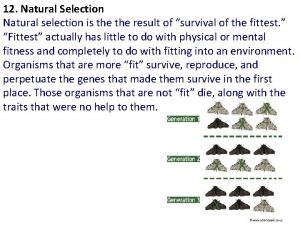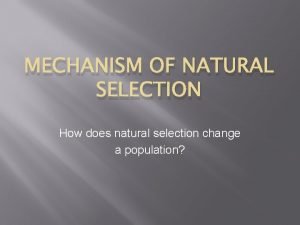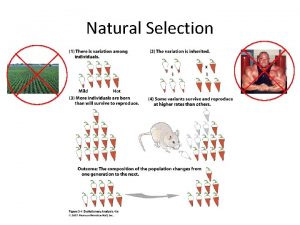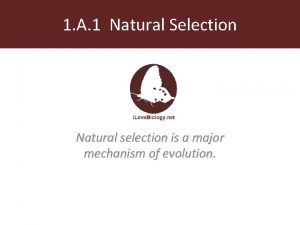GENETIC SIGNATURES OF NATURAL SELECTION Jamie Winternitz Institute































































- Slides: 63

GENETIC SIGNATURES OF NATURAL SELECTION Jamie Winternitz Institute of Botany and Vertebrate Biology, Czech Academy of Sciences

Outline of talk The Chimp and the River 1. • • Negative-frequency dependent selection Phylogenetic methods The Island Fox 2. • • Balancing selection Accounting for demography Men in the Mountains 3. • • Positive selection Genome scans

A strange set of symptoms 1980 s USA Opportunistic infections Ubiquotious fungus Pneumocystis jirovecii Oral candidiasis (yeast) Depleted wbc counts (thymus-dependent lymphocytes) Kaposi’s sarcoma Something is wrong with the immune system

Clusters of infection AIDS high incidence in homosexuals linked by sexual interactions -> infectious disease Incidence among intravenous drug users -> bloodborne Cases among hemophiliacs who received processed/filtered blood transfusions ->must be a virus

“Patient 0” (Zero) A Canadian airline steward named Gaëtan Dugas was referred to as "Patient 0" in an early AIDS study by Dr. William Darrow of the CDC 2500 sexual partners

HIV Worldwide

HIV variation Retrovirus (Reverse transcription) No proofreading = high error rate For a virus with a genome about 10 thousand bases in length, that means that basically every time HIV replicates itself, it makes a mistake. High viral production 108 copies per day Recombination, genetic drift, genetic shift, bottlenecks and immune-driven selection

HIV Types & subtypes HIV-1 group M is responsible for 95% of HIV infections globally. HIV-2 Group M Group N Group O Group P Africa Discovered Aug 2009 A B C D F G H J K Recombinants Worldwide distribution

SIV in captive primates >30 African Old World monkey species are naturally infected with various SIV strains Absent in Asian Old World monkey species

Symptoms of SIV Monkey hosts appear to tolerate heavy viral loads No pathogenic effects Suggests long coevolution

SIV precursor to HIV

Cross-species transmission Chimps may have contracted SIVlike infection from Old World Monkeys

Spillover

Zoonotic transfers of SIV to humans have been documented on no fewer than eight occasions Bontrop and Watkins 2005.

HIV: Where

HIV: When 2 samples from same year, same city: 1959 -60 Kinshasa, DRC. 12% genetic distance between DRC 60 and ZR 59 directly demonstrates that there were already at least two distinct clades of HIV in 1960. MRCA ~1890 -1920 Worobey et al 2008 Nature

Major Histocompatibility Complex � MHC Gene Family MHC immune genes of vertebrates Self vs. non-self High diversity T-cell receptor peptide MHC

Structure & function of MHC Class I � Receptors on all cells � Intracellular pathogens � Cytotoxic “Killer” Tcells Class II � B-cells and lymphocyes � Extracellular pathogens

MHC evolution MHC gene lineages are shared across primates Humans and chimps share 98. 6% genetic similarity Bontrop and Watkins 2005.

MHC Supertypes and HIV Binding motifs across alleles that recognize same protein fragments Similar supertypes = similar binding affinities Short as 1 year or less to a lack of disease progression after more than 35 years and counting in some rare individuals. Supertype associations.

Cross-species protection Some chimpanzee MHC class I-restricted immune responses target conserved epitopes of the HIV-1 virus These Patr alleles are characterized by relatively high frequency numbers. Identical viral epitopes are recognized by human long-term nonprogressors de Groot and Bontrop Retrovirology 2013 10: 53

SIV, HIV and primate MHC resistance 16 14 12 dif in alleles 10 ratio 8 6 4 2 0 Mhc-A Mhc-B Mhc-C

Selective sweeps and genetic hitchhiking Evidence of reduced MHC I variation Extant variation recognizes/resists HIV-1 Evidence of lost MHC Class II loci

Outline of talk The Chimp and the River 1. • • Negative-frequency dependent selection Phylogenetic methods The Island Fox 2. • • Balancing selection Accounting for demography Men in the Mountains 3. • • Positive selection Genome scans

Balancing selection Selection alters allele frequencies. Selection for even “balanced” allele frequencies

Genetic drift Genetic drift alters allele frequencies Sampling error with sexually reproducing individuals (Effective) population size matters

Island Fox “The San Nicolas Island fox (Urocyon littoralis dickeyi) is genetically the most monomorphic sexually reproducing animal population yet reported and has no variation in hypervariable genetic markers. “ Aguilar A et al. PNAS 2004; 101: 3490 -3494

Problems with reduced diversity Lower resistance to pathogens Reduced fitness (deleterious recessive alleles unmasked) Problems in distinguishing kin from non-kin

Population history Levels of genetic variation reflect population size and colonization history San Nicolas Island population having the second smallest effective population size and a recent colonization history Aguilar A et al. PNAS 2004; 101: 3490 -3494

Fox neutral genetic variation Mean heterozygosity (number alleles)

Selective pressures on fox Canine pathogens Recent canine distemper epidemic Inbreeding avoidance and discriminates between kin and non-kin in territorial encounters

Has MHC variation been maintained? Objective Quantify MHC variation Compare MHC variation before and after population separation Simulations To determine whether MHC variation has been maintained by natural selection despite the intense genetic drift implied by the genetic monomorphism of neutral genetic markers: Assess genetic variability at two class II MHC genes (DRB and DQB) and three class II MHClinked microsatellite loci. Compare variation in San Nicolas Island foxes with those on the other Channel Islands � � estimate levels of MHC variation in populations ancestral to the San Nicolas population account for the influence of population history on levels of MHC variation. Simulations to establish the intensity of selection needed to maintain the observed heterozygosity

Results: MHC variation Mean heterozygosity (number alleles) Similar MHC allelic diversity to ancestral populations

Results: Simulations SMM: stepwise -mutation model for microsatellites IAM: infinitealleles model for MHC μ: mutation rate Heterozygosity ~ effective population size x mutation rate x selection coefficient

Strength of selection LD between DQB and microsats, but not DRB and microsats Genetic monomorphism at neutral loci and high MHC variation could arise only through: � � � an extreme population bottleneck of <10 individuals ≈10– 20 generations ago unprecedented selection coefficients of >0. 5 on MHC loci. (range: 0. 05– 0. 15 in nature) High periodic selection “rescued” MHC diversity

Critique of story Lack of LD between DRB and microsats. Strong recent selection should show association between microsats near DRB and DRB alleles. Hedrick 2004. Heredity 93, 237– 238

Critique of story DRB shows no variation at all on San Miguel or San Clemente Islands Hedrick 2004. Heredity 93, 237– 238

Critique of story If DRB were the gene under strong balancing selection, then it is surprising that it shows no variation at all on San Clemente Island, a much larger population. If strong selection on DRB, or even other closely linked loci, then the two closely linked MHC microsatellite loci would be expected to still show linkage disequilibrium with DRB. Combination of nonselective effects (founder effects) and not -so-extreme balancing selection responsible for empirical results

Meta-analyses and bottlenecks Most pops have less MHC variation than neutral variation. Why? Meta-analysis with 109 populations (17 studies) Positive values indicate loss of genetic diversity from pre -bottlenecked ⁄ control to bottlenecked populations.

Meta-analyses and bottlenecks Usually, selection acting on MHC loci prior to a bottleneck event, combined with drift during the bottleneck, will result in overall loss of MHC polymorphism that is ~15% greater than loss of neutral genetic diversity.

Outline of talk The Chimp and the River 1. • • Negative-frequency dependent selection Phylogenetic methods The Island Fox 2. • • Balancing selection Accounting for demography Men in the Mountains 3. • • Positive selection Genome scans

Men of the mountains In 1924 George Mallory and Walter Irvine, 2 first Europeans thought to have achieved summit of Mount Everest, vanished on the descent.

Death on the mountain In 1998, Mallory’s body was discovered frozen on slope Since 1922, over 250 people have died climbing Everest, majority due to events exacerbated by acclimatization issues

The Death Zone Above 8, 000 metres (26, 000 ft) “Drunk”, fatigue, headaches, nausea, loss of appetite, earringing, blistering and purpling and of the hands and feet, and dilated veins Body tries to get more oxygen to the brain by increasing blood flow -> swelling High Altitude Cerebral Edema (HACE) High Altitude Pulminary Edema (HAPE)

High altitude adaptations Decreased oxygen availability (>2, 500 m) Decreased barometric pressure Physiological changes � increased lung volumes, � increased breathing � higher resting metabolism � hemoglobin changes

Geography of human adaptation to high altitude Andean Altiplano, Ethiopian Highlands, Tibetian Plateau Populated 11, 000 - 25, 000 years ago Bigham et al 2010. PLOS Genetics

Genome scans for selection Goal: Identify candidate genes for high-altitude adaptation based on signatures of positive selection in Tibetian and Andean populations What are we looking for? How do we know if the region is under selection vs random variation between individuals?

Design of study Contrast high-altitude populations with lowaltitude population controls 1. 2. 2. 3. Andean vs Mesoamerican and East Asian Tibetan vs European and East Asian Use 4 different complimentary tests of natural selection Compare independent high-altitude population results

Tests of natural selection 1) natural-log ratio of heterozygosity (ln. RH) 2) standardized difference of Tajima’s D 3) whole genome long range haplotype (WGLRH) Statistical significance determined using genomewide empirical distributions generated by data.

1) Ratio of heterozygosity (ln. RH) Natural log of ratio of heterozygosity between 2 pops of interest (High vs Low altitude pops) Sliding window of 100, 000 bp in 25, 000 bp increments along a chromosome window sliding Negative ln. RH values = regions with reduction in variation in high altitude population

Tajima’s D Under neutrality: (Average #pairwise polymorphisms-standardized #segregating sites)/std. Dev(d) Average Heterozygosity = # of Segregating sites E(π)= (4+0+4)/3 = 2. 67 E(S) = 4 sites/(1/1+1/2) = 2. 67 D = 2. 67 -2. 67/sqrt[Var(d)] = 0, Neutrality If Avg. Het > Segregating sites, D>0: Intermediate freq alleles, Balancing selection or recent pop bottleneck that removed rare alleles If Avg. Het < Segregating sites, D<0: High freq of singletons, Positive or purifying selection, selective sweep

Worked D examples 1 2 3 4 5 6 7 8 A 0 1 0 0 0 B 0 0 0 1 1 C 0 0 0 1 0 D 0 1 0 0 1 2 3 4 5 6 7 8 A 1 1 1 0 0 0 B 0 0 0 0 C 0 0 0 0 D 0 0 0 0 Must know the standard deviation to determine significance

Frequency spectrum In a standard neutral model � � � Random mating Constant population size No population subdivision Singletons Many low freq-variants High freq-variants

2) Standardized difference in D Negative standardized D = regions under selection in high altitude population controlling for demographic events

3) Whole genome long range haplotype (WGLRH) Young allele (neutral) • Low frequency • Long range LD • No time for recombination Frequency Old allele (neutral) • Low or high frequency (drift) • Short range LD • Lots of recombination Young selected allele • High frequency • Long-range LD • Hitch-hiking of linked sites Chromosome

Long range haplotype Compare Relative Extended Haplotype Homozygosty to flexible gamma distribution parameterized with maximum likelihood methods from rest of dataset Values in upper 5% tail of gamma distribution = regions under positive selection in high altitude population

Results: individual ancestry estimates Andean Tibetan

Results: population stratification Andean Tibetan

Results: Genome scans MANY significant SNPs for both populations, varying by test Strength of selection, time since selection, and recombination background all affect signal and test sensitivity

Results: Genetic variation at cellular oxygen sensing gene E: Haplotypes with arrow showing highest significant SNP Grey region is gene THM: Adaptation has occurred independently at this A&B: Allele frequency gene in the two highland groups distribution of 2 highest ranked SNPs for Andeans and Tibetans Derived =Red Positive selection =Black C: Significant are in Red for Andeans D: and for Tibetans

Take Home Message The Chimp and the River 1. • Phylogenetic methods to detect selection in a parasite and host The Island Fox 2. • Balancing selection to resist effects of drift, but be careful with conclusions Men in the Mountains 3. • Positive selection across the genome can affect different region for convergent phenotypes

Acknowledgements The excellent popular science book Spillover: Animal Infections and the Next Human Pandemic by David Quammen Funding Sources: European Social Fund in the Czech Republic, European Union, Ministry of Education, OP Education for Competitiveness, Veda vsemi smysly (CZ. 1. 07/2. 3. 00/35. 0026)

Thanks for your attention!
 Disruptive selection
Disruptive selection Natural selection
Natural selection Genetic drift vs gene flow vs natural selection
Genetic drift vs gene flow vs natural selection Mechanisms of evolutionary
Mechanisms of evolutionary Artificial selection vs natural selection
Artificial selection vs natural selection Natural selection vs artificial selection
Natural selection vs artificial selection Difference between continuous and discontinuous variation
Difference between continuous and discontinuous variation Disruptive selection.
Disruptive selection. Natural selection vs artificial selection
Natural selection vs artificial selection Genetic drift vs genetic flow
Genetic drift vs genetic flow Genetic programming vs genetic algorithm
Genetic programming vs genetic algorithm Genetic programming vs genetic algorithm
Genetic programming vs genetic algorithm What is the difference between genetic drift and gene flow
What is the difference between genetic drift and gene flow What is the difference between genetic drift and gene flow
What is the difference between genetic drift and gene flow Dsa vs rsa digital signature
Dsa vs rsa digital signature Parallel key signatures
Parallel key signatures Spectral signatures
Spectral signatures Compact multi-signatures for smaller blockchains
Compact multi-signatures for smaller blockchains Exchange 2007 signatures
Exchange 2007 signatures Uncitral model law on electronic transferable records
Uncitral model law on electronic transferable records Intruders use virus signatures fabricate
Intruders use virus signatures fabricate Order of sharos
Order of sharos Uncitral model law on international commercial arbitration
Uncitral model law on international commercial arbitration Ocaml signatures
Ocaml signatures Balancing selection vs stabilizing selection
Balancing selection vs stabilizing selection K selection r selection
K selection r selection Clumped dispersion
Clumped dispersion Two way selection and multiway selection in c
Two way selection and multiway selection in c Multiway selection
Multiway selection Procedure of pure line selection
Procedure of pure line selection Requirements for natural selection
Requirements for natural selection 4 principles of natural selection
4 principles of natural selection Stabilizing selection definition
Stabilizing selection definition Genetic drift
Genetic drift Different types of natural selection
Different types of natural selection Natural selection theory
Natural selection theory What basketball player has aids
What basketball player has aids 3 types of natural selection
3 types of natural selection Bird beak adaptation lab
Bird beak adaptation lab 3 types of natural selection
3 types of natural selection Natural selection
Natural selection Genetic drift
Genetic drift Natural selection
Natural selection Natural selection ted ed
Natural selection ted ed Natural selection
Natural selection What was lamarck's theory of evolution
What was lamarck's theory of evolution Natural selection foldable
Natural selection foldable Natural selection vs evolution
Natural selection vs evolution Three types of selection
Three types of selection Artificial selection
Artificial selection 4 principles of natural selection
4 principles of natural selection Analougous
Analougous Evolution is gradual
Evolution is gradual Three types of selection
Three types of selection Criteria for natural selection
Criteria for natural selection Natural selection simulation at phet answers
Natural selection simulation at phet answers What is evolution
What is evolution Basic principles of natural selection
Basic principles of natural selection Four steps to natural selection
Four steps to natural selection Natural selection steps
Natural selection steps Doc ff-1 pill test
Doc ff-1 pill test Natural selection steps
Natural selection steps Natural selection definition
Natural selection definition Basic principles of natural selection
Basic principles of natural selection
